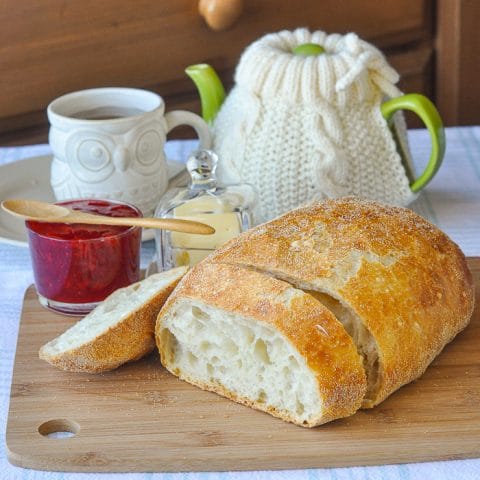How to Make No Knead Bread
4.5
(100)
Your folders
Your folders
Prep Time: 10 minutes
Cook Time: 50 minutes
Total: 13 hours
Servings: 12
Author : Copyright Barry C. Parsons 2019

Ingredients
Export 3 ingredients for grocery delivery
Instructions
Step 1
In a large bowl, mix together the flour, salt and yeast.
Step 2
Add the water and stir with a wooden spoon until everything combines together into a soft dough. It really does take less than a minute.
Step 3
Cover the bowl with plastic wrap and leave overnight. I have left it rising for 12- 15 hours many times. The time here is quite forgiving. Somewhere in that time window or even an hour or so before is fine.
Step 4
When ready to bake your bread, put a cast iron or enamelled cast iron dutch oven (including the lid) in the oven at 450 degrees F, for at least a half hour. The size of the dutch oven I use for a singe loaf is 3 1/2 quarts/litres and measures 8 inches across the top diameter. I also have a 7 quart/litre orange dutch oven which measures about 11 inches across. That one is what I use to make double sized loaves when doubling the recipe.
Step 5
Any oven-safe covered casserole is also good to use. I have made a single loaf of this bread in a white Corelle covered casserole as well. Just make sure your covered dish is rated for up to 450 degrees but you can get away with using 425 as well. When using a casserole, form the dough into a log shape, a little shorter than the length of the covered dish.
Step 6
To form the dough into a ball, turn it out onto a well floured surface. The dough will be VERY sticky at this stage, so don't be afraid of using lots of flour on the board. Flouring your hands often also helps.
Step 7
Sprinkle flour over the surface of the dough. Enough so that you can pat the dough without your hands sticking.
Step 8
Pat the dough flat into what ever shape it goes. The shape is not important.
Step 9
Begin folding the dough over on itself until a rough ball forms.
Step 10
Using well floured hands, begin tucking the loose ends under the dough to form a smooth ball. Don't worry too much about this. Your loaf may look a bit more rustic but it will still be fine.
Step 11
Cut a circle of parchment paper about twice the size of the diameter of the dough ball and place the dough ball on it.
Step 12
Lightly dust the top of the ball with flour and cover with a clean tea towel or napkin for 15- 20 minutes. This allows the dough to relax and get more elastic when baking, resulting in a higher loaf.
Step 13
After the resting time, you can score a cross in the top of the loaf using a razor blade or very sharp paring knife. A new clean box cutter is also good for scoring dough. You don't want to cut deeply at all. A quarter inch deep cut is fine.
Step 14
Lift the dough ball using the parchment paper and drop it directly into the hot dutch oven. An optional step at this point (but one I always do) is to spritz plain water all over the top of the dough before putting on the lid. I do about a dozen pumps from my kitchen water spritzer. The purpose is to provide steam and prevent the top crust from forming too fast, therefore getting better "oven Spring" or lift when baking, for the highest loaf.
Step 15
Put the dutch oven back in the oven for 1/2 an hour with the lid on. Then remove the lid and bake for an additional 15 -25 minutes depending on how dark you want to take the top crust.
Step 16
Cool the fully baked loaf on a wire rack for at least 45 minutes before cutting. Cutting prematurely, releases the steam from inside the loaf, leaving it drier and not so long lasting.
Step 17
I do freeze these loaves often. When I defrost a loaf, I put it back in a preheated 350 degree F oven, directly on the oven rack for 7-10 minutes. This refreshed the crust quite nicely.